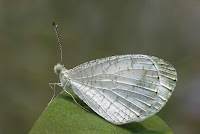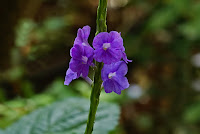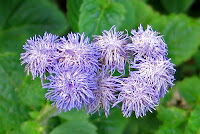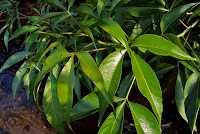<> Leptosia nina (Fabricius, 1793) <>
the Psyche ขาวแคระ
Click on any photo to see all photos full size in Lightbox
Additions and corrections to the information provided on this page is always welcome. Please use the Contact form.
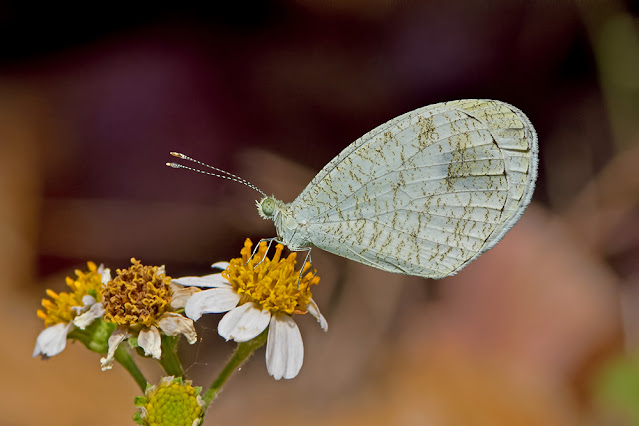
Photo taken at Doi Suthep-Pui National Park, Chiang Mai, Thailand 420m a.s.l.

Leptosia nina is one of only two members of its genus to be found in Asia (the other being L.lignea which is endemic on Sulawesi, Indonesia), the rest are all located on the African continent. There is little visual difference between the sexes and the species is distributed across the whole of the SE Asia region. It prefers open forest areas where there is dense undergrowth under the shade of trees and rarely ventures into more sunny parts. It tends to be most active in the early morning and late afternoon and although it favours lower light levels it rarely goes into the more dense parts of the forest. It flies low, in and around the undergrowth, in a weak and rather erratic fashion. It is one of the few butterflies that can still be seen on damp or overcast days.
The species is multivoltine and having a relatively short lifecycle produces multiple generations each year. The adult female lays her eggs singly on the underside of a leaf, near the midrib, on the host plant. On hatching, the larva eats the eggshell as its first meal.
Synonyms and previously used names: Papilio nina, Papilio xiphia, Leptosia chlorographa, Leptosia xiphia, Pontia crokera, Pontia niobe, Pontia dione, Pontia xiphia, Nychitona xiphia, Leptosia aurisparsa
Taxonomy: Animalia - Arthropoda - Insecta - Lepidoptera - Pieridae - Pierinae - Leptosia - nina
Regional subspecies: Leptosia nina fumigata (Indonesia), L.n.georgi (Philippines), L.n.nina (India, Bangladesh, Myanmar, Thailand, Laos, Cambodia, Vietnam, S.China), L.n.malayana (S.Thailand, Malaysia, Singapore, Indonesia), L.n.niobe (Taiwan), L.n.terentia (Philippines). There are a few others scattered amongst the islands of Indonesia.
Regional Distribution: Nepal, Bhutan, India, Bangladesh, Myanmar, Thailand, Laos, Cambodia, Vietnam, China, Taiwan, Malaysia, Singapore, Indonesia, Philippines
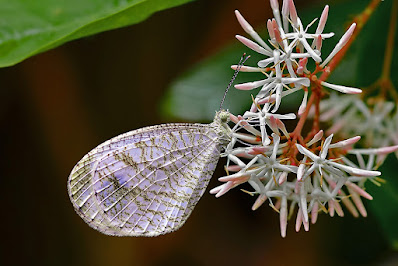 |
Mae Kampong, Chiang Mai, Thailand 1030m a.s.l. |
Habitat: Leptosia nina is found in a wide range of habitats including open areas within lowland and montane forest, forest edges, grassland, gardens, parks, and wasteland. Seen mostly at low elevations but has been recorded up to 1800m a.s.l. in the eastern Himalayas.
Flight time: most of the year depending on location Wingspan: 35-45mm
Life History: egg 3 days instar 1 2-3 days instar 2 2-3 days instar 3 2-3 days instar 4 2-3 days instar 5 2-4 days pupa 5-6 days Total egg to adult 20-24 days
All times are approximate and can vary depending on the season and on the host used.
Larval Hosts: Brassica juncea, Brassica oleracea, Cardamine hirsuta, Nasturtium officinale (Brassicaceae), Cadaba fruticosa, Capparis acutifolia, Capparis floribunda, Capparis grandis, Capparis lanceolaris, Capparis micracantha, Capparis sepiaria, Capparis sikkimensis, Capparis spinosa, Capparis zeylanica, Cleome aspera, Cleome gynandra, Cleome rutidosperma, Cleome viscosa, Crateva adansonii, Crateva magna, Crateva religiosa (Capparaceae), Azima tetracantha (Salvadoraceae), Rhamnus parvifolia (Rhamnaceae), Mimosa pudica (Fabaceae), Ixora coccinea, Mussaenda frondosa (Rubiaceae).
Actual host plant used depends upon location and availabilty of plant species.
Adult Food Sources: Nectar - Duranta erecta, Lantana camara, Stachytarpheta indica, Stachytarpheta jamaicensis (Verbenaceae), Ageratum conyzoides, Bidens pilosa, Blainvillea acmella, Chromolaena odorata, Clibadium surinamensis, Cosmos bipinnatus, Cyanthillium cinereum, Elephantopus scaber, Mikania micrantha, Synedrella nodiflora, Tagetes erecta, Tridax procumbens (Asteraceae), Allium tuberosum (Alliaceae), Momordica charantia (Cucurbitaceae), Tetrastigma lanceolarium (Vitaceae), Turnera ulmifolia (Passifloraceae), Sida cordata (Malvaceae), Blepharis maderaspatensis (Acanthaceae), Evolvulus alsinoides (Convolvulaceae), Pigea enneasperma (Violaceae), Oxalis barrelieri (Oxalidaceae), Platostoma axillaris (Lamiaceae). Other - mud puddling (occasional), bird droppings
Links to other pages in this series for species in the same subfamily

